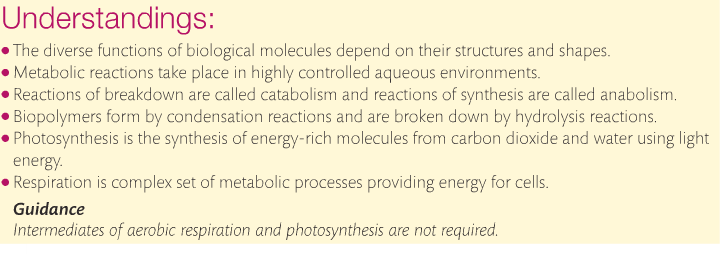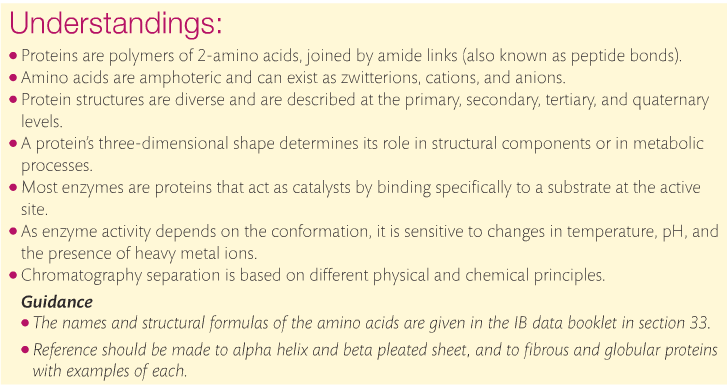Here is a link to biochemistry basics that focuses on the "BIO" part. This material comes from IB biology. My expectation is that you go through each of the links and take notes on the material. We will focus on the "CHEMISTRY" part in class and add to the existing links.
B1 begins with an introduction. Subtopics are: metabolic pathways, biomolecules, condensation & hydrolysis reactions, photosynthesis & respiration.
B1 begins with an introduction. Subtopics are: metabolic pathways, biomolecules, condensation & hydrolysis reactions, photosynthesis & respiration.
Amino acids are monomers just like monosaccharides. They are building blocks for proteins just like monosaccharides are building blocks for carbohydrates. An amino acid contains an amino group and a carboxyl group attached to a central carbon atom with a terminal hydrogen and a variable group denoted as “R.” The R group is different for each amino acid, of which there are 20 naturally occurring. As a result, there are endless variations of amino sequences. Here are the structures of the needed 20 amino acids. Notice that the only difference is the "R" group. The aminos are called 2-amino acids because the R group attaches to the second carbon.
Ribosomes connect amino acids to make proteins. Condensation reactions allow the process to take place. The process produces a peptide bond that creates a protein and a water molecule. Peptide bonds combines two amino acids to make a dipeptide. A chain of amino acids forms a polypeptide, and most proteins are polypeptides. When polypeptides are synthesized at ribosomes under the control of DNA, the reaction that takes place is a condensation reaction. The amino acid sequence is determined by the DNA, but the condensation reactions are the same.
Proteins have a variety of functions. As a result, they have many different forms and structures. Function follows form, which means the function of any particular protein is closely related to its structure. Protein structures are 3D; they can be folded, elongated, and helical. When proteins are folded, hydrogen bonds stabilize the molecule. There are four levels of protein structure: primary, secondary, tertiary, and quaternary.
Ribosomes connect amino acids to make proteins. Condensation reactions allow the process to take place. The process produces a peptide bond that creates a protein and a water molecule. Peptide bonds combines two amino acids to make a dipeptide. A chain of amino acids forms a polypeptide, and most proteins are polypeptides. When polypeptides are synthesized at ribosomes under the control of DNA, the reaction that takes place is a condensation reaction. The amino acid sequence is determined by the DNA, but the condensation reactions are the same.
Proteins have a variety of functions. As a result, they have many different forms and structures. Function follows form, which means the function of any particular protein is closely related to its structure. Protein structures are 3D; they can be folded, elongated, and helical. When proteins are folded, hydrogen bonds stabilize the molecule. There are four levels of protein structure: primary, secondary, tertiary, and quaternary.


 RSS Feed
RSS Feed